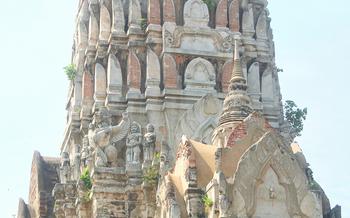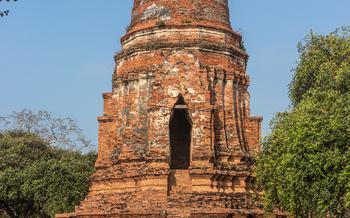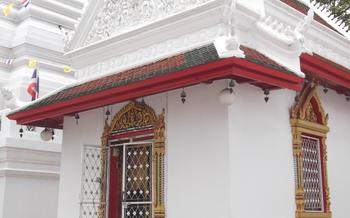
Wat Siburi Rattanaram
- Wat Siburi Rattanaram: A Spiritual Haven
- Exploring the Temple Grounds
- Paying Homage to Buddha Images
- Experiencing the Local Culture
- Attending Temple Festivals
- Exploring the Surrounding Area
- Photography and Videography
- Meditation and Spiritual Retreats
- Volunteer Opportunities
- Accommodation and Dining Options
- Transportation and Accessibility
- Respectful Behavior
- Insider Tip: Hidden Gem
Wat Siburi Rattanaram: A Spiritual Haven
Wat Siburi Rattanaram, nestled in the serene landscapes of Saraburi, Thailand, is a captivating temple that beckons travelers and pilgrims alike. Its history dates back to the Ayutthaya period, around the 16th century, when it was initially constructed as a small hermitage for wandering monks. Over time, it evolved into a significant religious center, attracting devotees from near and far.
The temple's architectural style is a testament to the artistic prowess of the Ayutthaya era. Its towering prang, adorned with intricate carvings, rises majestically towards the heavens, symbolizing the connection between the earthly and celestial realms. The ubosot, or ordination hall, features elegant murals depicting scenes from the life of Buddha, narrating his journey from birth to enlightenment.
Wat Siburi Rattanaram is not merely a place of worship but also a vibrant hub for religious ceremonies and festivals. Throughout the year, the temple hosts an array of events, each steeped in deep-rooted Buddhist traditions. The annual temple fair, held during the Songkran festival in April, is a spectacle of color, music, and festivities, drawing thousands of visitors who come to pay homage to Buddha, make merit, and partake in the joyous celebrations.
Exploring the Temple Grounds
The temple complex of Wat Siburi Rattanaram boasts a captivating layout, with a central courtyard surrounded by elegant structures and serene gardens. As you enter, your eyes will be drawn to the main ordination hall (ubosot), a magnificent edifice adorned with intricate carvings and gleaming golden spires. Inside, a colossal Buddha image exudes an aura of tranquility, inviting visitors to pause and reflect.
Notable structures within the temple include the impressive chedi, a towering spire that represents the Buddha's teachings and symbolizes the path to enlightenment. The chedi is adorned with delicate stucco work and colorful ceramic tiles, showcasing the artistry and craftsmanship of the temple's builders.
Throughout the complex, you will encounter a diverse collection of sculptures, murals, and other artistic elements that tell stories from Buddhist mythology and illustrate the life of the Buddha. The temple walls are adorned with vibrant murals depicting scenes from the Buddha's journey, offering a glimpse into his teachings and the principles of Buddhism.
The temple's serene gardens and tranquil ponds create a harmonious blend of nature and spirituality. Wander through the lush greenery, where colorful flowers bloom and birdsong fills the air. Take a moment to sit by the pond, surrounded by the soothing sounds of water, and let the tranquility of the temple wash over you.
Paying Homage to Buddha Images
The temple enshrines a diverse collection of Buddha images, each holding unique symbolism and significance. The principal Buddha image, known as Luang Pho Phra Buddha Rattana Mongkhon, is a colossal standing Buddha statue that commands attention with its intricate details and serene expression. This revered image is believed to bring blessings of peace, prosperity, and protection to those who pay homage.
Other notable Buddha images within the temple include the reclining Buddha, known as Phra Phuttha Saiyas, which invites visitors to reflect on the impermanence of life and the cycle of rebirth. The emerald Buddha, known as Phra Phuttha Morakot, exudes a captivating aura of tranquility and is believed to possess special powers. Visitors can also seek blessings from the Buddha of Compassion, known as Phra Phuttha Metta, whose gentle gaze and benevolent demeanor inspire feelings of love and kindness.
When paying homage to the Buddha images, it is customary to follow certain rituals and practices. Visitors typically offer flowers, incense, and candles as tokens of respect and gratitude. Lighting a candle symbolizes the dispelling of darkness and ignorance, while offering flowers represents the purity and impermanence of life. Devotees may also engage in meditation or chanting mantras to connect with the Buddha's teachings and cultivate inner peace.
Experiencing the Local Culture
Immerse yourself in the local culture at Wat Siburi Rattanaram by interacting with the friendly monks and temple staff. Observe religious ceremonies and rituals, gaining insights into Thai Buddhist traditions. Participate in meditation sessions or Dharma talks, deepening your understanding of Buddhist teachings and practices. Engage in conversations with the monks to learn about their daily lives, beliefs, and the history of the temple. Embrace the opportunity to connect with the local community and gain a deeper appreciation for Thai culture and spirituality.
Attending Temple Festivals
Wat Siburi Rattanaram comes alive during its annual temple festivals, which showcase the vibrant traditions and cultural heritage of Saraburi. The most prominent festival, held in November, is the Loy Krathong and Yi Peng festival, where thousands of locals and visitors gather to release beautifully decorated krathongs (floating baskets) and lanterns into the sky.
This festival symbolizes letting go of past grievances and misfortunes while embracing good luck and prosperity. Visitors can witness the spectacular sight of hundreds of colorful lanterns illuminating the night sky, creating a truly magical atmosphere. Other festivals throughout the year include Songkran (Thai New Year), Visakha Bucha (Buddha's birthday), and Makha Bucha (commemorating the Buddha's first sermon).
During these festivals, the temple hosts processions, merit-making activities, and cultural performances that provide a glimpse into Thai Buddhist traditions and beliefs. Participating in these festivals is a wonderful way to immerse oneself in the local culture and experience the festive spirit of Saraburi.
Exploring the Surrounding Area
Wat Siburi Rattanaram is nestled amidst a tapestry of cultural and historical attractions. Take a short walk to immerse yourself in the captivating history of the city. The Saraburi National Museum showcases a treasure trove of artifacts and exhibits, providing a glimpse into the region's rich past.
For a taste of nature's wonders, venture to the nearby Khao Sam Lan National Park. Hike through lush forests, marvel at cascading waterfalls, and spot exotic wildlife. Embrace the tranquility of nature as you soak in the breathtaking views from the mountain peaks.
Indulge in the vibrant local markets, where you can haggle for souvenirs, savor delectable street food, and witness the bustling energy of Thai commerce. Immerse yourself in the local flavors and aromas as you explore the culinary delights of Saraburi.
When planning your day trip or extended stay, consider exploring the surrounding villages and communities. Engage with the friendly locals, learn about their way of life, and discover hidden gems that offer a glimpse into the authentic Thailand. Embrace the opportunity to connect with the people and culture that make this region so special.
Photography and Videography
Capturing the essence of Wat Siburi Rattanaram through photography and videography is a rewarding experience. However, it's crucial to approach this with respect and mindfulness. Photography and videography are permitted within the temple grounds, but visitors must adhere to certain guidelines.
When photographing or filming, avoid using flash or tripods that may obstruct or disturb other visitors or ceremonies. It's important to maintain a respectful distance from monks and other individuals engaged in religious practices. Seek permission before taking photos or videos of monks, as they may prefer not to be photographed.
Focus on capturing the architectural details, sculptures, murals, and serene atmosphere of the temple. Experiment with different angles and lighting conditions to showcase the beauty and uniqueness of the temple's surroundings. Remember to respect the privacy of others and avoid taking photos or videos that may be intrusive or disrespectful.
By following these guidelines, you can create stunning visual memories of your visit to Wat Siburi Rattanaram while honoring the sacred nature of the temple environment. Share your experiences and photos responsibly through social media, using relevant hashtags and tagging the temple's official accounts to connect with other visitors and enthusiasts.
Meditation and Spiritual Retreats
Wat Siburi Rattanaram offers a unique opportunity for visitors to embark on a journey of meditation and spiritual development. The temple provides various meditation programs and retreats, ranging from beginner-level introductions to advanced practices. These programs are conducted by experienced teachers who guide participants through different meditation techniques and teachings based on Buddhist principles.
Participants in meditation retreats can explore various forms of meditation, including mindfulness meditation, loving-kindness meditation, and vipassana meditation. These practices aim to cultivate inner peace, clarity, and compassion, helping individuals to connect with their true nature and find deeper meaning in life. The tranquil environment of the temple, surrounded by lush gardens and serene ponds, provides an ideal setting for meditation and self-reflection.
Whether you are a seasoned practitioner or a curious beginner, Wat Siburi Rattanaram's meditation programs offer a transformative experience that allows you to deepen your spiritual understanding and cultivate a sense of inner peace and well-being.
Volunteer Opportunities
Wat Siburi Rattanaram offers visitors the opportunity to engage in meaningful volunteer work, contributing to the temple's upkeep and supporting the local community. Volunteering at the temple is a rewarding experience that allows visitors to immerse themselves in Thai culture, connect with the local people, and make a positive impact.
There are various ways to volunteer at the temple, depending on one's skills and interests. Volunteers can assist in temple maintenance tasks such as cleaning, gardening, or helping with construction projects. Those with a passion for education can volunteer to teach English or other subjects to local children or monks. Additionally, volunteers can participate in social welfare projects or community events organized by the temple, such as food distribution or medical check-ups.
Volunteering at Wat Siburi Rattanaram is a fulfilling experience that provides visitors with a deeper understanding of Thai Buddhist culture and the local way of life. It is an opportunity to give back to the community, make new friends, and create lasting memories. The temple welcomes volunteers from all backgrounds and experiences, and provides guidance and support throughout the volunteering period.
Whether you are looking to contribute your skills, learn new things, or simply make a difference, volunteering at Wat Siburi Rattanaram is a rewarding and enriching experience that will leave a lasting impact on both you and the community.
Accommodation and Dining Options
Wat Siburi Rattanaram offers basic accommodation facilities for visitors seeking a tranquil and immersive temple experience. Within the temple grounds, there are a limited number of guest rooms and dormitories available, providing a simple yet comfortable stay. Guests can choose from rooms with shared or private bathrooms, depending on their preference.
For those seeking more privacy and amenities, there are several hotels and guesthouses located within a short distance from the temple. These accommodations range from budget-friendly options to mid-range hotels, catering to different travelers' needs and budgets. Some popular choices include the Saraburi Palace Hotel, The Park Hotel Saraburi, and the Saraburi Grand Hotel.
Dining options near Wat Siburi Rattanaram are plentiful, offering a variety of Thai and international cuisines. Visitors can find local restaurants serving authentic Thai dishes, such as pad thai, som tum, and khao soi, at affordable prices. There are also several cafes and coffee shops in the area, providing a relaxing spot to enjoy a break and soak in the local atmosphere.
For those who prefer to dine within the temple grounds, there is a vegetarian restaurant that serves simple yet delicious meals. The restaurant is open during lunchtime and offers a variety of dishes prepared using fresh, locally sourced ingredients. Visitors can enjoy a peaceful and mindful dining experience in the serene surroundings of the temple.
Transportation and Accessibility
Getting to Wat Siburi Rattanaram from Bangkok and Other Cities
Wat Siburi Rattanaram is situated in the Saraburi province, approximately 110 kilometers northeast of Bangkok. To reach the temple from Bangkok, visitors can take a bus or train from the capital's Northern Bus Terminal or Hua Lamphong Railway Station. Buses depart frequently throughout the day, and the journey takes about two and a half hours. Trains are a more comfortable option but have fewer departures. Once in Saraburi, visitors can take a local bus or taxi to the temple, which is located about 15 kilometers from the city center.
Public Transportation Options and Routes
For those who prefer to travel by public transportation, buses and trains offer convenient and affordable options. Buses depart from Bangkok's Northern Bus Terminal and stop at the Saraburi Bus Station. From there, visitors can transfer to a local bus or take a taxi to the temple. Trains departing from Hua Lamphong Railway Station stop at the Saraburi Railway Station. From the station, visitors can take a local bus or taxi to the temple.
Hiring a Car or Motorbike for Greater Flexibility
Renting a car or motorbike offers greater flexibility and independence for exploring the temple and the surrounding area. Several car rental agencies are available in Bangkok and Saraburi, and motorbike rentals can be found in Saraburi town. When driving in Thailand, visitors should be aware of the local traffic laws and customs, and always wear a helmet when riding a motorbike.
Parking Facilities and Accessibility for Visitors
Wat Siburi Rattanaram provides ample parking space for visitors. The parking area is located near the temple entrance and is accessible by both cars and motorbikes. Visitors with disabilities can request assistance from the temple staff, who are always willing to help.
Respectful Behavior
When visiting Wat Siburi Rattanaram, it is essential to be mindful of your behavior and conduct. The temple is a sacred space for worship and meditation, and visitors are expected to act respectfully.
Here are some guidelines to follow:
-
Maintain Silence and Minimize Distractions: During ceremonies and religious rituals, silence should be observed. Avoid talking, laughing, or making loud noises that may disturb others. Turn off your mobile phone or set it to silent mode.
-
Ask Permission Before Taking Photos or Videos: Before taking photos or videos of monks, always ask for their permission. It is considered disrespectful to take photos or videos without their consent.
-
Show Gratitude and Appreciation: When interacting with the temple staff and monks, show gratitude and appreciation for their kindness and hospitality. A simple "thank you" or "wai" (traditional Thai greeting with hands pressed together in front of the chest) can go a long way.
Insider Tip: Hidden Gem
While Wat Siburi Rattanaram is a renowned temple in Saraburi, there's another hidden gem worth exploring nearby. Just a short drive away, nestled amidst tranquil rice fields, lies Wat Phai Lom. This lesser-known temple boasts a unique charm and serenity that attracts a small but dedicated following.
Wat Phai Lom is renowned for its stunning Buddha image, known as Luang Pho To. This majestic image, crafted from a single block of white marble, exudes an aura of peace and tranquility. Visitors are drawn to the temple to pay homage to Luang Pho To and seek blessings for good fortune and happiness.
In addition to its sacred Buddha image, Wat Phai Lom is surrounded by lush gardens and tranquil ponds, creating a serene atmosphere that invites contemplation and reflection. Visitors can wander through the temple grounds, enjoying the natural beauty and soaking in the peaceful ambiance.
To fully immerse yourself in the local culture, consider participating in one of the temple's meditation sessions or Dharma talks. These sessions, often led by experienced monks, offer a unique opportunity to learn about Thai Buddhist traditions and practices.
Wat Phai Lom may not be as well-known as Wat Siburi Rattanaram, but its hidden charm and spiritual significance make it a worthwhile destination for those seeking a more intimate and authentic temple experience.




